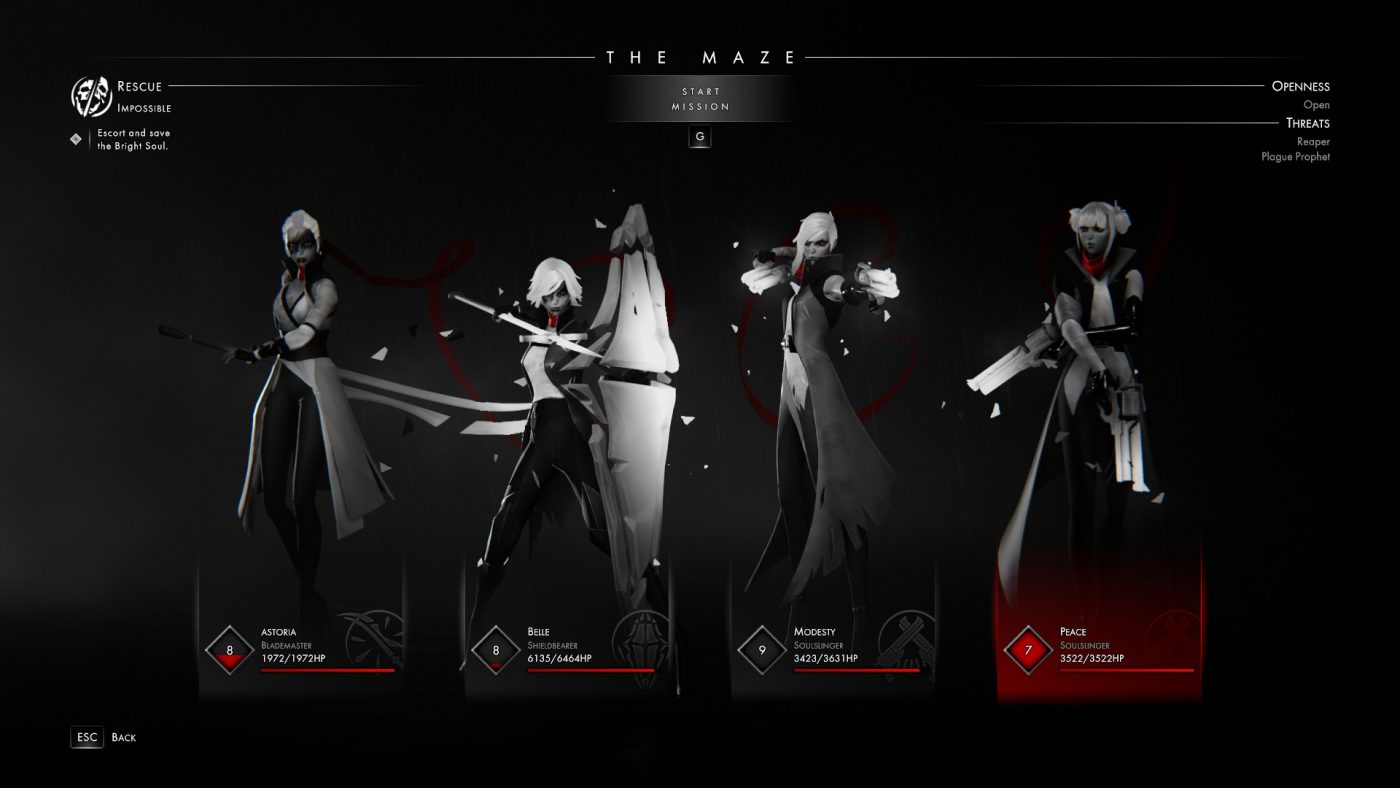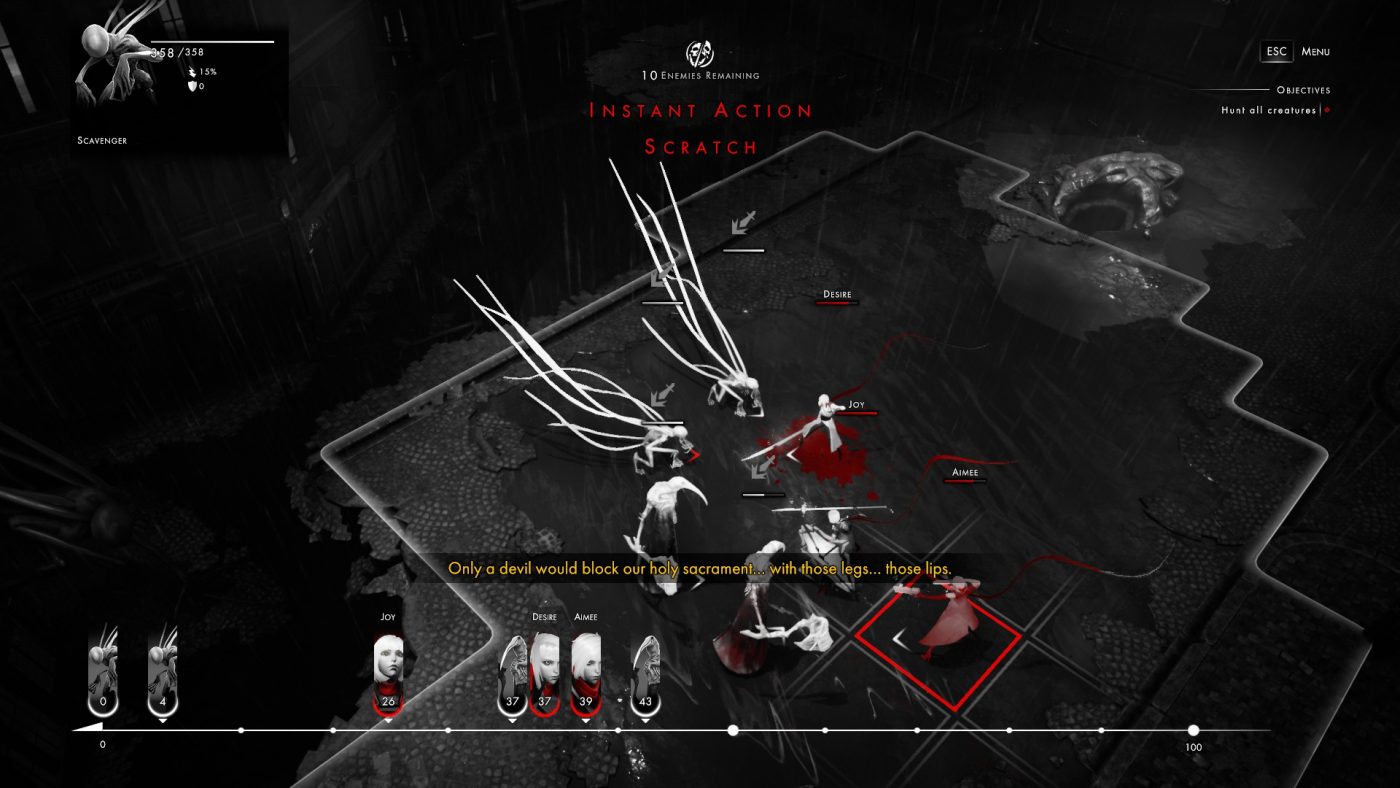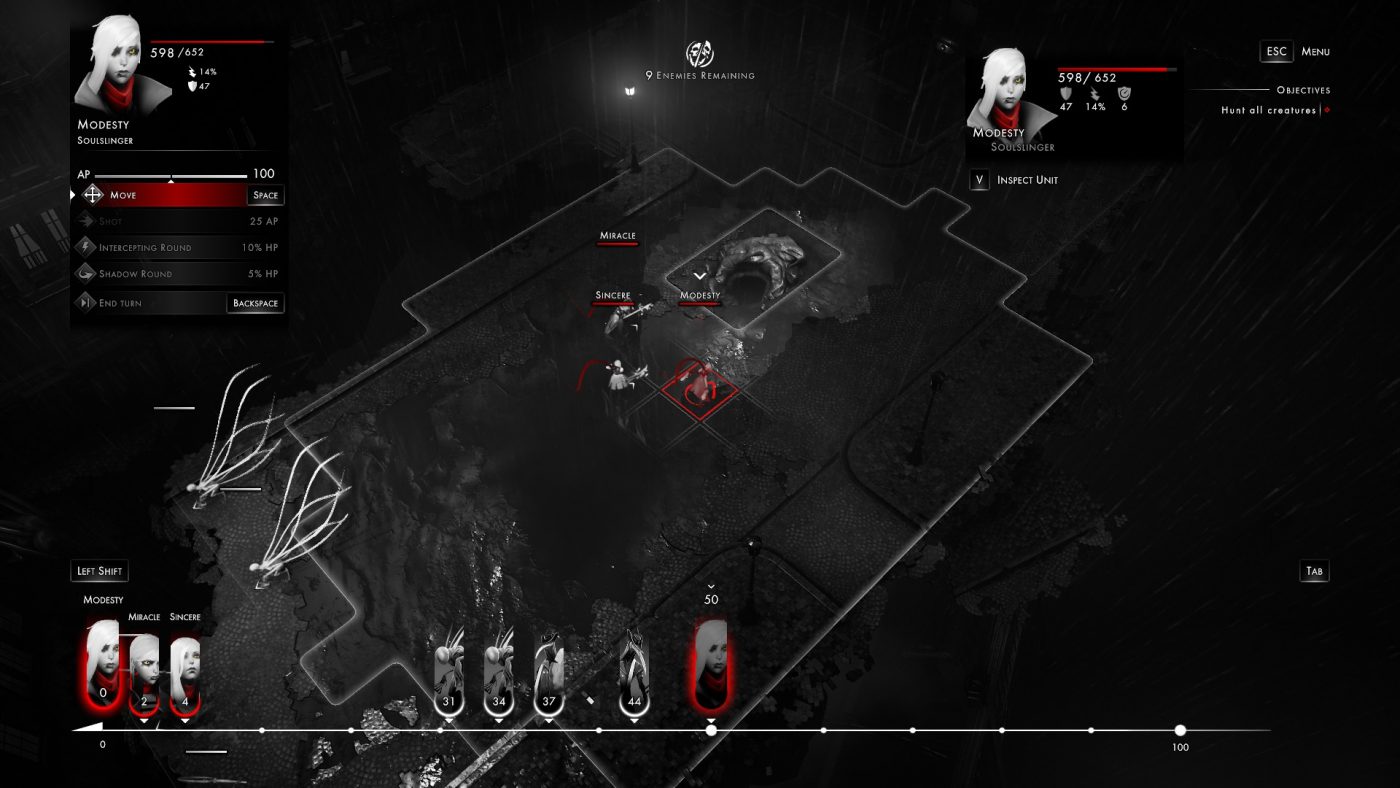Othercide is probably what you’d get if you made XCom but the designers had been obsessed with 90’s Brandon Lee goth swansong The Crow and 18th century plague doctors. And then put a central roguelike mechanic in it. Because why not, eh?
Your role is The Mother, an eternal being fighting through the ages against the Suffering. You do this by wielding your Daughters against the massed hordes of nightmares, cultists and other agents of this unknowable darkness.
Each Daughter is germinated (actually the official term used in-game, because this game really likes using obtuse terminology) and is assigned a type; Shieldbearer, Souslinger or Blademaster (essentially tank/defensive, ranged and offensive units). You then take on Recollections (a roguelike run through) where you close Synapses (missions), earning Vitae to germinate more Daughters. Vitae is also used to assign Memories (modifiers) to Daughters abilities. Then you get to take on a boss and inevitably get your arse handed to you, at least at first. And if (when) you fail a boss that’s that run over with.
You then start a new run, but you start with 3 new Daughters, the old ones being consigned to the graveyard as a penalty of death. Any Memories you found are unequipped and discarded, as are any unused ones.
Once you start the new run you can use Shards, a currency acquired as rewards for successful mission completion along with Vitae and XP, to activate any Remembrances you have unlocked. Remembrances are run modifiers which afford you boones such as the resurrection tokens to bring back lost Daughters from the graveyard (levels, abilities, traits and all), modifiers right from the beginning to equip to abilities, health boosts or even the means to skip an entire Era. Era is the term for the collection of Synapses which end with a boss battle.
Right, does that make sense? Are we keeping up? It’s quite difficult to parse a lot of this information initially because hoo boy does this game love its nouns. Thematically the game is incredibly sincere and stoic, with a Sin City/Tim Burton’s Sleepy Hollow black/white/red aesthetic and very deliberate terminology, descriptions and lore.

If I’m honest, that part of the game is exhausting.
Aesthetics aside, the game has some interesting and rather satisfying gameplay mechanics. When in a mission there is an initiative timeline where friendly and enemy units are placed in turn order. Each action you take uses up the Action Points of that unit, be it moving or using an attack or giving a boost to a friendly unit and then moves you accordingly down the initiative track, placing you in front of or behind enemies and friendly units chronologically.
Each action is divided up into Instant, Reaction or Delayed. All are pretty self explanatory; instant is, well, instant, reaction activates when certain conditions have been met (such as an enemy moving into melee range) and delayed is usually a powerful move which requires a certain amount of time on the initiative track before it activates.
As you level Daughters they acquire new abilities, so you can tailor them for mission versatility, although after a while I found I started taking certain abilities every time they came up as they proved to be the most dependable in the majority of situations.
The way these abilities interact with other Daughters is key to succeeding. For example, Soulslinger has a Reaction named ‘Intercepting Round’. This ability will interrupt the first attack on a friendly unit within 10 spaces, preventing that attack and dealing a little damage to the attacking unit. The enemies tend to attack the nearest Daughter to them and so keeping a Soulslinger in range of your other units is beneficial.
The downside to powerful reaction abilities like Intercepting Round is that they cost a percentage of your maximum health instead of AP, which is a blessing and a curse as you can use up your AP on movement and hitting things in the face and then prepare a reaction as well. The large downside to using health as a currency is there’s no way to heal your Daughters in mission.

The only way to heal units is to ‘Sacrifice’ a Daughter to another Daughter. The problem with this is you can only sacrifice a Daughter of the same or higher level, so you can’t just spawn a level 1 unit and smash it into a level 5. Once you’ve sacrificed one into another the surviving Daughter retains a trait from the unit used to heal her, which is usually a decent boost like damage increase, more health or an increase to crit chance.
This healing mechanic means you’re strategically cycling your Daughters out of play. Early in the Era you can germinate more Daughters to feed to the ones of equal level before they ding over to the next, and this feels a bit creepy. Spawning new units just so they can be fodder is a grim notion. But the games lore is steeped in grim notions so at least it fits in with the nature of it.
However it doesn’t stop being galling when you cannot heal that higher level Daughter with lots of traits because none of your units are high enough level to be sacrificed so you have to consign her to the graveyard.
Trying to balance the levels of your Daughters and their health for when you get to a boss is a central mechanic to the game but the static nature of the early Eras in terms of XP awarded in each level mean that you can’t grind your way to levelling your units.
You’re forced to push on with the progression through the eras as the difficulty assigned to missions seems to be tied to the amount of enemy units instead of the actual strength of the enemies in them.

If you can balance the strength of your group makeup and maintain the health of your best units you could probably progress through the game at a steady rate and not really encounter the difficulty it warns you against at the beginning.
Othercide has a lot going for it mechanically and aesthetically. The art style is consistent and strong, and the enemies have definite silhouettes that you can tell them at a glance when you’re only a few battles in. It has a great sense of weight to the combat with chunky, squelchy sound effects and the way abilities manipulated the initiative timeline left me with a sense of satisfaction few games have given me.
If I’m honest this game, and this review, has fought me every inch of the bloody way. I spent a long time in Othercide wondering if I was playing it wrong. Every time I thought I had a grasp on the sacrifice mechanic, and how powerful I was supposed to be it’d slip between my fingers. It’s clear cycling your units and making use of your limited resurrection tokens is key but I never truly wrapped my head around it.
I think the biggest problem is that the two largest components of the game don’t really satisfy me on either level. As a rogue-like the runs are too long and offer too little reward for the effort of maintaining that run.
As a turn based strategy it’s difficult to get that satisfaction of building up a strong battalion of units to take into battle when you’re having to feed your strong ones to the weaker, and the limited number of resurrections per run compound that.
But I still kept going back and see if I could figure that out, and to push on to the next boss. And the next. So that has to count for something. I guess anything that generates a compulsion to return to figure out its mysteries can’t be a bad thing.

